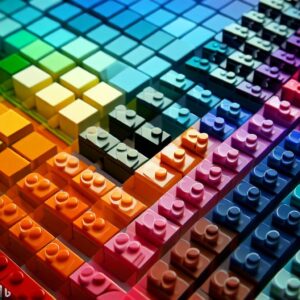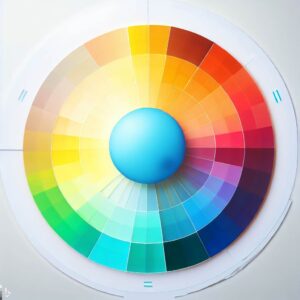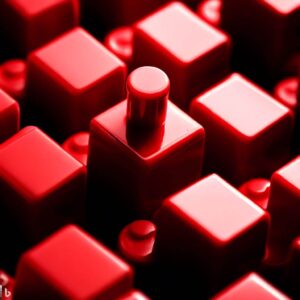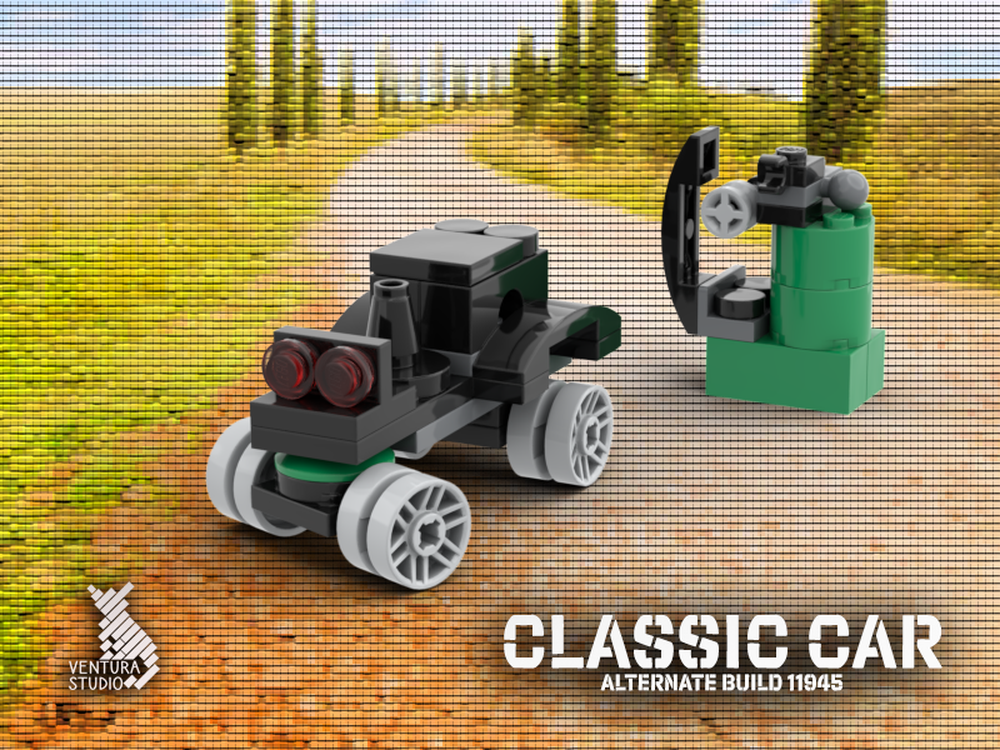Blog
-
The LEGO Color Palette: A Fascinating Journey of Colors!
Posted on 29 Apr 2023 10:58
The LEGO Color Palette: A Colorful Journey!
The development of the color palette in LEGO bricks over the years has been an incredibly fascinating process. Initially, in the early LEGO sets, only basic colors such as red, blue, yellow, green, white, black, and gray were available. However, as LEGO’s technology and manufacturing capabilities advanced, new shades and nuances of colors began to emerge. This resulted in LEGO sets becoming more diverse in terms of colors, allowing for greater creativity and variety in model building.Currently, the LEGO color palette boasts an impressive array of 39 different shades, spanning a wide range of colors from classic and vibrant hues to more unique and sophisticated colors like pink, turquoise, and metallic gold. The introduction of new colors provides LEGO builders with even more freedom to create unique models and express their creativity.
The evolution of the LEGO color palette over the years serves as a great example of how the LEGO company adapts to the needs and expectations of its fans, offering new and interesting color options that inspire further play and creation with LEGO bricks.
How Does Color Work in LEGO Bricks? Understanding the Basics of Color Theory
Color is an incredibly important element in LEGO bricks, as it affects how we perceive and perceive models built with these bricks. Understanding the basics of color theory can help us understand how color works in LEGO bricks.
The fundamentals of color theory are based on three basic elements: hue, saturation, and brightness. Hue refers to the characteristic of color that allows us to distinguish one color from another, such as red, blue, or green. Saturation refers to the intensity of color, or how pure and full a given color is. Brightness, on the other hand, refers to the level of brightness or darkness of a color.
In LEGO bricks, color is achieved using special pigments added to the plastic raw material from which the bricks are produced. Different pigments allow for the creation of different colors, such as red, blue, yellow, green, white, black, and many others.
Color in LEGO bricks is also related to their design. LEGO bricks are designed to be compatible with each other and can be combined in various combinations to create models of different shapes and sizes. Through careful selection of colors, LEGO builders can create models that are aesthetically appealing and aligned with their vision.
Color theory is also important in the process of designing models with LEGO bricks. Understanding color harmony, contrasts, and other principles of color theory can help in creating impressive and aesthetically balanced models.
In summary, color in LEGO bricks is a complex element that affects how we perceive models built with these bricks. Understanding the basics of color theory can help in the conscious use of colors in the process of building LEGO models and creating attractive and unique constructions.

Organizing the Color Palette in LEGO Bricks: Bright, Dark, Satin, and Sand Shades.
Organizing the color palette in LEGO bricks can be a creative process that allows for the creation of diverse and aesthetically appealing models. Among the colors available in LEGO palettes, several categories can be distinguished, such as bright, dark, satin, and sand shades.
Bright colors are categories of colors that are more intense and vibrant, characterized by high saturation. These can include bright shades of blue, green, red, or yellow. Bright colors are often used to create contrasts and add dynamism to LEGO models, especially for models that are intended to be visually expressive.
Dark colors are categories of colors that are more subdued and darker. These can include dark shades of blue, green, brown, or black. Dark colors are often used to create shadows and depth in LEGO models, and to give them a more mysterious or serious character.
Satin colors are categories of colors that are characterized by a glossy and delicate finish, giving them an elegant appearance. These can include satin shades of gold, silver, copper, or pearl colors. Satin colors are often used to create metallic effects or other unique elements in LEGO models, adding a luxurious look to them.
Sand colors are categories of colors that are characterized by a subtle matte finish resembling sand. These can include shades of sandy beige, light brown, or khaki. Sand colors are often used to create natural elements in LEGO models, such as deserts, beaches, or rocky formations, adding a realistic look to them.
Organizing the color palette in LEGO bricks can be a creative process that allows for the creation of interesting and diverse models. Using different categories of colors, such as bright, dark, satin, and sand shades, can add character, depth, and aesthetic charm to LEGO models.
The color palette of LEGO bricks is based on saturation, brightness, and hue.
The color palette of LEGO bricks is rich and diverse, allowing for endless combinations and patterns. To understand the color palette of LEGO bricks, it’s important to familiarize yourself with basic concepts such as saturation, brightness, and hue, which are key in color theory.
Saturation refers to the intensity of a color, or how “pure” a color is. Higher saturation indicates a more intense color, while lower saturation can result in more subdued or muted colors. LEGO bricks offer both highly saturated colors, such as vibrant reds, blues, greens, and yellows, as well as colors with lower saturation, such as pastels or more muted shades.
Brightness refers to the level of brightness of a color, or how much light is reflected or absorbed by a color. Light colors reflect more light, making them brighter, while dark colors absorb more light, making them darker. LEGO palettes include both bright colors, such as white, yellow, or blue, as well as dark colors, such as black, brown, or graphite.
Hue refers to the basic color, such as red, blue, green, etc. Hue can vary depending on color categories, such as warm colors (e.g., red, orange) or cool colors (e.g., blue, purple). LEGO bricks offer a wide range of hues in various color categories, allowing for creative combinations and contrasting of colors.
Understanding saturation, brightness, and hue of colors in LEGO bricks allows for more conscious and precise use of the color palette, creating interesting and harmonious compositions. Creativity and experimentation with different color combinations are essential aspects of building with LEGO bricks, allowing for limitless possibilities for expressing one’s own creativity and imagination.

The influence of saturation, brightness, and hue on the color palette of LEGO bricks.
Saturation, brightness, and hue are key elements that influence the color palette of LEGO bricks. Each of these aspects has its own characteristics that affect the final appearance of the color in LEGO bricks.
Saturation refers to the intensity of color. Higher saturation indicates a more intense color, while lower saturation can result in more muted or subdued colors. LEGO color palettes can include both highly saturated colors, such as bright reds, blues, greens, or yellows, as well as colors with lower saturation, such as pastels or more subdued shades. Saturation affects the impression of dynamism, energy, and color intensity, which can add vivid and distinctive characteristics to LEGO bricks.
Brightness refers to the level of brightness of a color, or how much light is reflected or absorbed by a given color. Bright colors reflect more light, making them brighter, while dark colors absorb more light, making them darker. LEGO color palettes can include both bright colors, such as whites, yellows, or blues, as well as dark colors, such as blacks, browns, or grays. Brightness affects the impression of contrast, readability, and color clarity in the context of the surroundings, which can give LEGO bricks diverse visual effects.
Hue refers to the basic color, such as red, blue, green, etc. Hue can vary depending on color categories, such as warm (e.g. red, orange) or cool (e.g. blue, purple). LEGO bricks offer a wide range of hues in different color categories, allowing for diversity and visual complexity in built constructions. Hue affects the impression of mood, atmosphere, and emotions that can be expressed through LEGO bricks.
Understanding the influence of saturation, brightness, and hue on the color palette of LEGO bricks allows for more precise composition and mixing of colors, creating harmonious or contrasting color combinations.
What is the difference between “bright red” and “red” in LEGO bricks? Understanding LEGO color terminology.

In the world of LEGO bricks, color terminology can be slightly more precise and complex than in everyday language. An example of this can be the difference between “bright red” and “red”.
In the case of LEGO colors, “bright” refers to the brightness level of the color, or how much light is reflected by the color. “Bright red” will therefore denote a red color with a higher brightness level, meaning a brighter version of the color red. On the other hand, “red” refers to the base color, which is the general shade of red.
In practice, this means that “bright red” will be more diluted and brighter compared to “red”, which will be more saturated and darker. An example of a “bright red” LEGO brick could be a red brick from the Classic series, which has a lighter shade of red, while a “red” LEGO brick could be more intense and darker, such as a brick from the Technic series.
Understanding LEGO color terminology can be helpful when precisely composing colors in built constructions. Understanding the difference between “bright” and “red” allows for more conscious use of colors and creating intended visual effects in built models.The influence of luminance on color hue in LEGO bricks: from pastel to intense shades.
Luminance, or the level of brightness of a color, can have a significant impact on the hue of colors in LEGO bricks. Depending on the level of luminance, LEGO bricks can exhibit a wide range of shades, from pastel to intense.
In the case of pastel shades, which are characterized by a lower level of luminance, colors are more subdued and delicate. These are colors that appear “muted” or “faded”, often used to create subtle, delicate, or nostalgic effects in built LEGO models. Examples of pastel shades in LEGO bricks include pastel pink, pastel blue, or pastel green.
On the other hand, intense shades, which are characterized by a higher level of luminance, are more vibrant, saturated, and contrasting. These are colors that grab attention and are suitable for creating strong, bold, and dynamic effects in built LEGO models. Examples of intense shades in LEGO bricks include bright red, bright green, or bright blue.
The influence of luminance on the color hue in LEGO bricks can be significant, as it can affect the overall appearance and visual impressions of built constructions. Conscious use of different levels of luminance allows for achieving desired visual effects, such as subtlety, intensity, or contrast, depending on the intended purpose of the LEGO project.
LEGO bricks in shades of gray: from black to bluish gray.
LEGO bricks in shades of gray offer a wide range of creative possibilities in building models. From deep black to subtle shades of bluish gray, the palette of gray colors in LEGO bricks allows for creating various visual effects.
Black is one of the most important shades of gray in LEGO color palettes. It is used both as a primary color for constructions and as an accent color, adding contrast and depth to other colors. The black color scheme can give LEGO models a more raw, modern, or atmospheric look.
In addition to black, LEGO color palettes also include various shades of gray, such as light gray, medium gray, dark gray, and bluish gray. These shades of gray allow for adding different levels of brightness and contrast to constructions, providing greater possibilities in building details and textures.
Shades of gray in LEGO bricks can be used to create various effects, such as shadows, depth, perspective, or gloss. They can be used in constructions that reflect realistic scenes, as well as in creating abstract, modern, or futuristic models. Shades of gray in LEGO bricks allow builders to express their creativity and create unique projects that reflect their individual style and vision.LEGO bricks in sand colors: applications and properties.
LEGO bricks in sand colors are a relatively new addition to the LEGO color palette, offering interesting possibilities in model building. Sand color is subtle, delicate, and neutral, making it popular for creating realistic scenes as well as original projects.
The applications of LEGO bricks in sand colors are diverse. They can be used to create natural elements such as sand on a beach, desert landscapes, rocks, or stones. Sand color can also serve as a background, fabric, or structure in architectural models such as buildings, castles, or bridges. Due to its neutral tone, LEGO bricks in sand colors are also frequently used in creating dioramas, vignettes, and displays where maintaining a natural look of the environment is important.
The properties of sand color in LEGO bricks include its delicacy, subtlety, and naturalness. Sand color is neutral, which means it easily complements other LEGO colors, both light and dark, allowing for many combination possibilities. Bricks in sand color are also typically matte, giving them a unique appearance and texture that sets them apart from other LEGO colors with a shinier surface.
LEGO bricks in sand colors are appreciated by builders for their versatility, as they allow for the creation of diverse projects, both realistic and creative. Their neutral tone and distinctive matte surface are additional advantages, enabling the creation of interesting details, textures, and visual effects in LEGO models.The real colors of LEGO bricks: why “white” is actually light orange, and “black” is very dark gray.
The actual colors of LEGO bricks can be surprising to some, as they are not always exactly as they appear at first glance. For example, the “white” color is actually a light shade of orange, and “black” is a very dark shade of gray. Why does this happen?
The reason lies in the manufacturing process of LEGO bricks. When the bricks are made from plastic, various types of dyes are used to give them the desired colors. However, for technical and economic reasons, it is not always possible to achieve perfectly accurate colors, especially for light shades.
In the case of “white” LEGO bricks, the dye used is actually a light shade of orange. This is because achieving a perfectly white color in the production of plastics is difficult and expensive. Instead, a dye in a light shade of orange is used, which allows for an acceptable shade of “white” after the production process is completed.
Similarly, the “black” color of LEGO bricks is actually a very dark shade of gray. This is because achieving a true black color in plastics is difficult and can result in undesirable effects such as translucent molding lines or dimensional accuracy issues. Therefore, a very dark shade of gray is used, which is acceptable as the “black” color in LEGO bricks.
Although the actual colors of LEGO bricks may deviate from our expectations, it does not change the fact that they remain recognizable and useful in building various models and constructions. Knowledge of the actual colors of LEGO bricks can be useful in planning projects to avoid unexpected differences in color shades and achieve the intended effect in the final design.
It can be said that the issue of colors in LEGO bricks is fascinating and diverse. The history of color palette development, color theory, the influence of saturation, brightness, hue, and luminance on color, different color groups, and LEGO color terminology – all of this gives us a deeper understanding of how LEGO bricks present diverse colors. Discovering the real colors of LEGO bricks can be surprising, and knowledge about colors allows for more creative and diverse building with LEGO bricks. -
Mastering the Art of LEGO Model Building and Color Selection: A Comprehensive Guide
Posted on 10 Apr 2023 21:34
?? Building Your Own LEGO Models and Choosing Colors: A Two-Part Guide ??
Part 1: Building Your Own LEGO Models
Building your own LEGO models can be a rewarding and fun experience. Here are some tips to help you get started:
1️⃣ Plan ahead: Before you start building, take some time to plan out your model. Think about what you want to build, what features you want to include, and how you want it to look.
2️⃣ Choose the right pieces: Make sure you have all the pieces you need before you start building. If you're not sure what pieces you need, refer to LEGO instructions or use a LEGO digital designer tool to create a digital model first.
3️⃣ Start with a sturdy base: A strong foundation is essential for any LEGO model. Start by creating a sturdy base using larger pieces, and build up from there.
4️⃣ Use symmetry: Symmetry can add balance and beauty to your model. Try to create symmetry by using the same pieces on both sides of your model.
5️⃣ Add details: Details can make your model look more realistic and interesting. Use smaller pieces to add details like windows, doors, and other features.
Part 2: Choosing Colors for Your LEGO Models
Choosing the right colors for your LEGO model can be just as important as the building process. Here are some tips to help you choose the perfect colors:
1️⃣ Consider the purpose: Think about the purpose of your LEGO model. If it's a display piece, you may want to use bright, eye-catching colors. If it's a functional model, you may want to choose colors that match the real-life object you are building.
2️⃣ Use the color wheel: The color wheel is a useful tool for choosing complementary colors that work well together. Try to use colors that are next to each other on the color wheel, or colors that are opposite each other for a bold contrast.
3️⃣ Consider the environment: If your LEGO model will be displayed in a specific environment (e.g. a space-themed model in a dark room), you may want to choose colors that will stand out in that environment.
4️⃣ Use accent colors: Adding small accents of bright or bold colors can make your model more interesting and visually appealing.
5️⃣ Get inspired: Look for inspiration from other LEGO builders or from real-life objects. Study how they use colors and try to incorporate those techniques into your own models.
By following these tips, you'll be well on your way to building and designing your own amazing LEGO models! ???
-
Lego Batman and Lego Superman: A Tale of Two Heroes
Posted on 8 Apr 2023 10:56
Lego Batman and Lego Superman: A Tale of Two Heroes ???♂️
Lego Batman and Lego Superman are two of the most beloved Lego sets out there. These two iconic superheroes are known for their bravery, strength, and unwavering commitment to justice. But what is even more fascinating is the dynamic between these two heroes when they come together to fight evil.
At first glance, Batman and Superman might seem like two very different characters. Batman is a brooding, dark hero who prefers to work alone, while Superman is an optimistic, bright hero who always sees the good in people and works closely with others. But despite their differences, these two heroes share a deep respect for each other and often team up to take on the bad guys.
In the Lego Batman sets, Batman is often portrayed as grumpy and short-tempered, while Superman is sunny and cheerful ?. This creates a fun dynamic between the two characters, as Superman tries to cheer Batman up and get him to lighten up a bit ???. On the other hand, in the Lego Superman sets, the roles are often reversed, with Batman as the grumpy one and Superman as the one who tries to get Batman to see the good in people and trust in the power of teamwork ?♂️.
No matter which set you're playing with, it's clear that Lego Batman and Lego Superman make a great team. They might have different approaches to fighting crime, but they share a deep commitment to justice and a desire to make the world a better place ?. These two heroes show us that even when things seem tough, we can always count on our friends to have our back ????.
In the end, the Lego Batman and Lego Superman sets remind us that heroes come in all shapes and sizes, and sometimes the most powerful thing we can do is work together as a team ??️???. Whether you're a Batman fan, a Superman fan, or just a Lego fan in general, these sets are definitely worth checking out for a fun and unique take on these iconic characters ???♂️.
-
7 Alternative MOC for set 11945
Posted on 11 Dec 2022 20:59
7 Alternative MOC for set 11945 Steam Locomotive
All instructions are free to download on Rerbickable:have fun building it







Design by Dominik Wenta
-
International Wookiee Life Day on Kashyyk - 17.11.2022
Posted on 17 Nov 2022 11:44

Die-hard fans of the Star Wars saga are sure to have November 17 on their calendars as International Wookiee Life Day (often just Life Day for short). At least if they belong to the generation that was able to see the original trilogy in the cinema. For the rest of the galaxy far, far away, there is fortunately still the calendar of the curious holidays from all over the world, which brings some light into the darkness. What is this event from the Star Wars universe about?
Who created Wookiee Life Day?
Wookie Life Day in its current form is a genuine invention of the worldwide Star Wars fandom from 2009, making it another curious holiday from the galaxy far, far away, alongside Star Wars Day on May 4 and Talk Like Yoda Day. Of course, there's also a reference to August 19 as International Talk Like Jar Jar Binks Day.
Why does Wookiee Life Day fall on November 17?
For the first time, Star Wars fans proclaimed Wookiee Life Day on November 17, 2009. In doing so, the date went back to the 31st anniversary of the airing of the infamous Star Wars Holiday Special to hereby celebrate a "day of peace, a day of harmony."
In other words, the day was supposed to be an occasion to put on red Snuggies and get together with friends. Alcohol included. Attached is the original call from 2009, posted online by blogger fetts1138:
The first annual World Wide Wookiee Life Day is planned for Nov. 17, the 31st anniversary of the Star Wars Holiday Special. Anniversary of the Star Wars Holiday Special. I will be hosting a special screening of The Holiday Special at my favorite cantina, but everyone is encouraged to do the same wherever they are. What really makes this event a great one is Snuggies! Yes, you may have noticed that the Wookiees in the Holiday Special are wearing their red Snuggies for the day of. Well, finally the technology on Earth has come to the point where we are able to successfully replicate this Wookiee technology. I can't think of a better way to officially kick off the holidays by getting together with some friends, having a few drinks, and wearing red blankets with sleeves to celebrate "a day of peace, a day of harmony. "
(Source: worldwidewookieelifeday.blogspot.com)
-
Fast Food Day - 16.11.2022
Posted on 17 Nov 2022 11:09

Fans of the cultivated fast meal - watch out and join in. You should definitely make a note of November 16. At least according to the US culinary calendar, which lists this date as National Fast Food Day.




